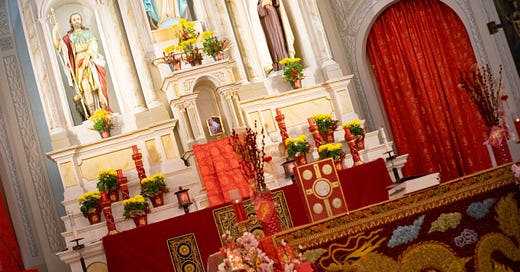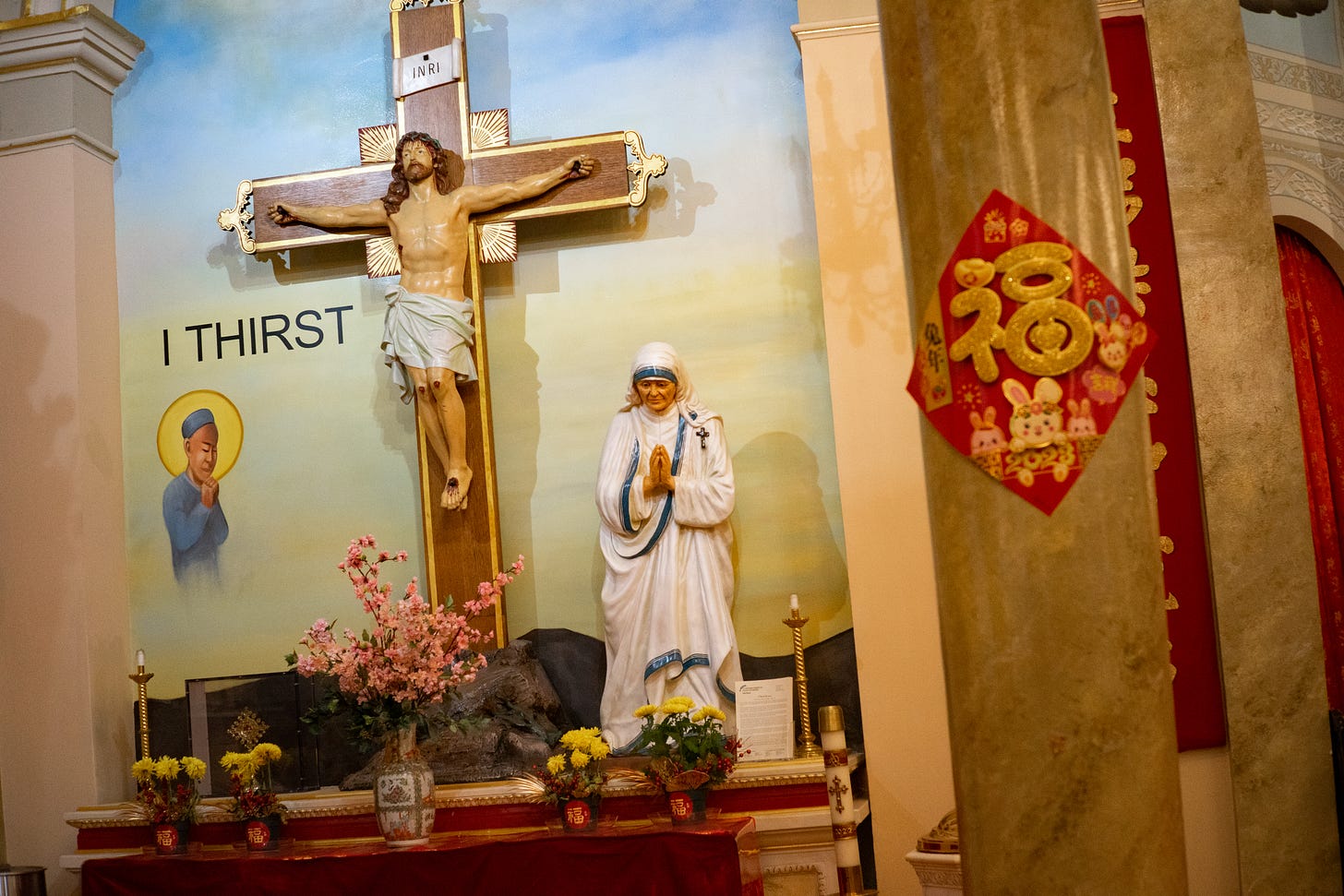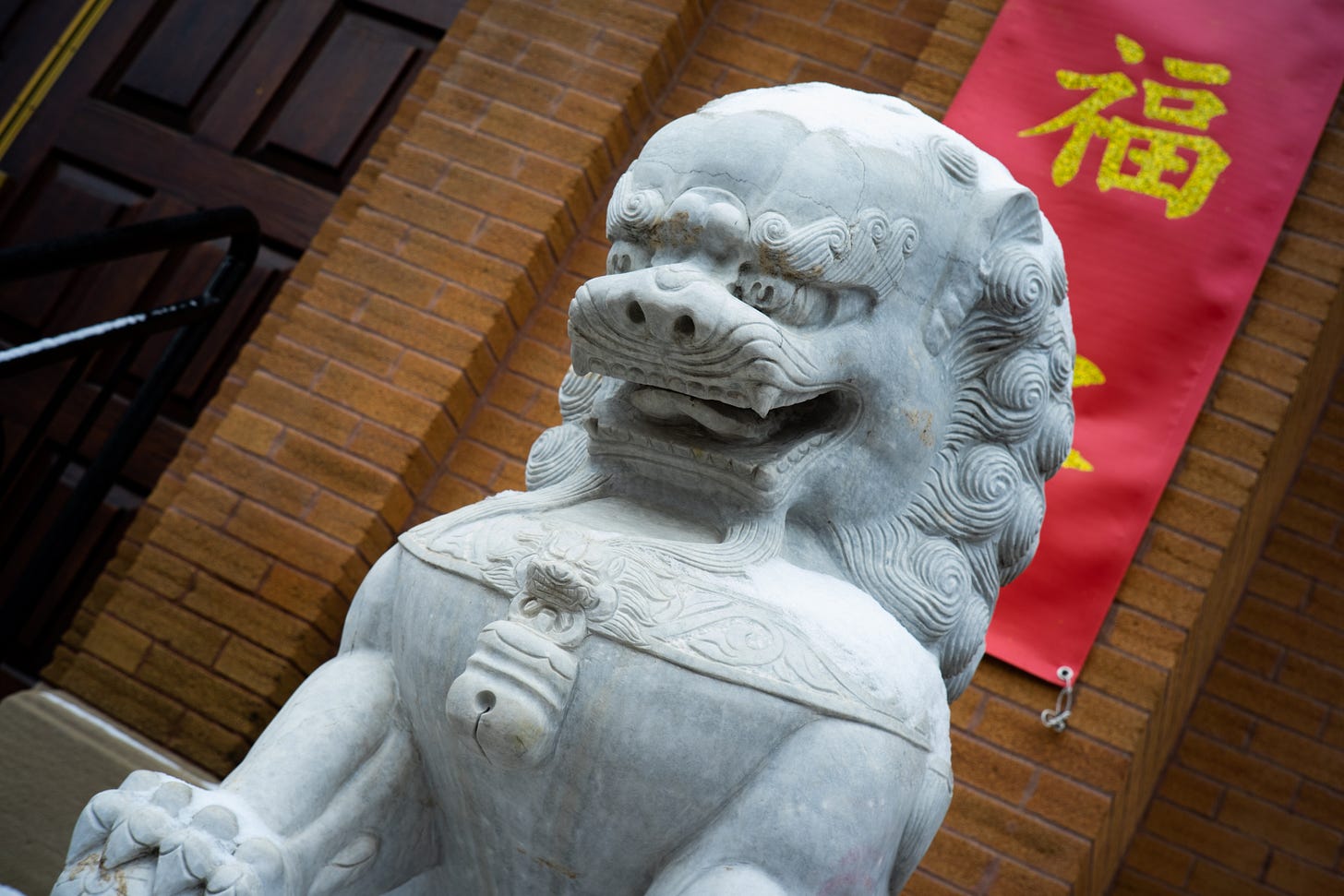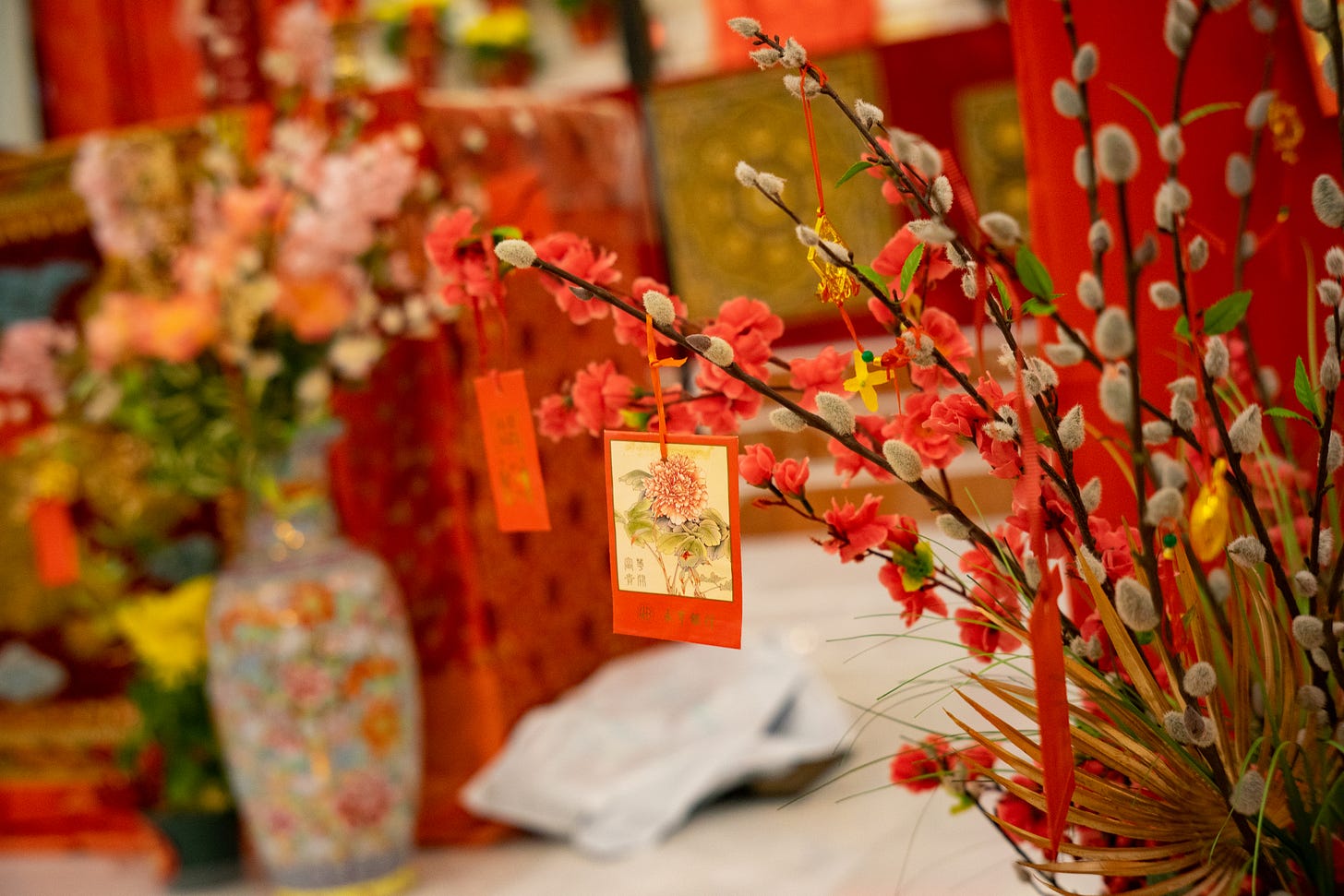Church Number 5: St. Terese Chinese Catholic Church
I was checking out Chicago’s Chinatown and poked my head in. The outside of this Catholic church is rather nondescript, built on a side street and in the middle of residential buildings.
But more interesting is the history of the church. The parish began in 1899, and the building was completed in 1904. And as with so many of the early Chicago churches, it was built to specifically address a group of immigrants: the Italians.
Why were the Italians flocking to Chicago and other cities in the United States in the late 1800s?
The story begins in 1871 when Italy became a unified nation. With Rome as its capital, the country adopted a democratic constitution. However, conditions in Southern Italy, also known as Mezzogiorno, had been much worse than those in Northern Italy, and after unification, they got even worse.
Most of the land in Italy was owned by a few wealthy nobles who lived in the north. In southern Italy, landless peasants suffered from poverty, cholera and malaria epidemics, and a parasite that destroyed most of the grapevines.
In 1870, only 25,000 Italian immigrants lived in the United States. Most of them were artisans and shopkeepers that came from northern Italy. After 1871, Italian immigrants coming through Ellis Island were poor farmers and laborers.
Then between 1880 and 1920 over four million Italians immigrated to the United States, the largest number of immigrants in such a short time. Estimates from 1890 are that 99% of Chicago's public works employees were Italians. And pretty much all were Catholic.
Most of these Italians did not speak English, and because the Catholic churches in Chicago were conducted in English, many stopped attending church. So the bishop brought in an Italian priest and in 1899 started a new church, Santa Maria Incoronata Church. The current building was finished in 1904.
One interesting fact about this church is that Al Capone’s mother, Teresine Capone, donated a large statue of Jesus on the Cross that remains in the church today.
Eventually, Italians started moving out of the neighborhood around the time of World War II. And the Chinese were moving in.
Chinese immigrants came to the United States to provide labor for both the transcontinental railroad and the gold rush. Most had settled in California. But in the 1870s, Californians were not happy with the increasing number of Chinese and accused them of taking low wage jobs from citizens. The state even went so far as to pass a law against Chinese immigration. So not surprisingly, many left the west coast and headed east, including to Chicago.
Eventually, the anti-Chinese sentiment spread throughout the entire country, and Congress passed the Chinese Exclusion Act in 1882, which stopped Chinese immigration and denied citizenship for those already in the US. Chicago was home to only about 1,000 Chinese at the time. And eventually they gathered into what is now Chicago’s Chinatown. (Today’s Chinatown is home to 14,000 Chinese.)
During World War II, when Japan attacked Pearl Harbor, the United States turned their hatred to the Japanese and grew sympathetic towards China, who had become their ally. It should be no surprise that in 1943, the Chinese Exclusion Act was finally repealed.
The Chinese who were Catholics were searching for a church. In 1940, they established the St. Therese Chinese Catholic Mission. In 1963, St. Therese merged with Santa Maria Incoronata, whose Italian congregation was disappearing. They moved to the Santa Maria Incoronata building and renamed themselves the St. Therese Chinese Catholic Church.
Then in 2019, the St. Therese Chinese Catholic parish and the St. Barbara parish merged under a new name, St. Teresa of Calcutta parish, taking on the patron saint, Mother Teresa. But the two churches have maintained their names.
Today, St. Therese is the only Chinese Catholic church in the Midwest. And out front two guardian lions, similar to those popular in Chinese Buddhism, welcome visitors
As far as my visit to this church, today was a lot!
First, I took the train even though I would have preferred walking. I have walked to the neighborhood of this church in the past, but today it was 24 degrees, so I opted for the train, which was an experience in and of itself. For one, no one is out and about in the city at 9 or 930 AM on a Sunday. The streets are empty and quiet, and so is the train.
The Red Line is not the safest train, and I don’t feel comfortable taking it after dark. But even in the day, it’s not good. In fact, yesterday, I was on the Red Line and a young, hotheaded man tried to pick a fight with a crazy homeless man. All of us on the car moved to the far end as this guy threatened to beat the crap out of the homeless guy. Fun times.
Today, I just missed the train so at first I was alone at the underground station, which I also really don’t like. Then a homeless man wandered in, noticed that the trash can was empty, and took the plastic trash bag and stuffed it in his coat. Ok.
Once I got on the train, there were only four of us. I was the only woman. One man in a balaclava stared at his phone. Another was drinking milk out of one of those old school lunch waxed cardboard pint boxes. The other was homeless. He was smoking a cigarette. Then he talked to himself for a while. Finally, he yelled out, “Does anyone have 36 cents? For church?”
I wandered around a bit trying to find the church. It is tucked away on a residential street and from any distance can’t be seen. When I finally found it, it seemed like it was closed. There was no activity around it, no people, and all the doors were closed. Often, churches have open doors and volunteers greet people. I didn’t know what to do, so I just hung around. Church started in five minutes, and still, no one was around. Then someone rushed up the stairs and went in, so I followed. I was greeted inside by two ushers with a program and a hymnal.
Then, holy cow. Where was I?? It felt like I walked into a Chinese restaurant.
The sanctuary is fairly small, with only 15 rows of pews. Stained glass windows line both sides of the sanctuary, each depicting a different person. In the center of the wall in the back of the altar is a statue of Mary. A large statue of Jesus on the cross is on the left side of the church, rows of votive prayer candles in front of it. This is the piece was actually donated when the church was still Santa Maria Incoronata by Teresina Capone, Al Capone’s mother!
It is an eclectic contrast of Italian art and Chinese decor. The architecture, the stained glass windows, the painted figures, the statues, the crystal chandeliers are all Italian. But the red banners with Chinese characters, the pink plum flowers, the dragon cloth hanging over the altar table, the lycee envelopes, and the red curtains come from the church’s Chinese history.
There is also a balcony in the back, and I could see that there were organ pipes up there. But the music was confusing. Speakers were in the front of the sanctuary, so even though the organ and choir was in the back, the sound was coming from the front of the church. Most of the time, the music was coming from a piano (or a piano setting on the organ?). One song featured the harp, and the last song included a full band with a guitar and drums.
The church held an Interesting mix of people: white, black, and mostly Chinese. There were also some elderly people who appeared to be Italian! But the church has other services every Sunday in Cantonese, Mandarin, and Indonesian, so obviously there is a wide variety of people in the congregation.
At the beginning, the priest and the altar children walked down the middle aisle to the front. The altar children were all Chinese and young - three boys and one girl. They were so cute. They were restless, always jockeying for position and directing each other. It was funny to watch.
The service began when someone asked us to greet and wave to those around us. So there I was, waving to people around me. God I hate that. So weird. To make matters worse, later in the service, we had to do it again. It was even more awkward the second time.
On the first song, a child a few rows behind me was singing so loudly!! I thought maybe a children’s choir was behind me, but no. Just the one little girl. But everyone in the congregation was so enthusiastic! Everyone sang wholeheartedly. I didn’t recognize most of the chants and responses or the songs that people sang from memory rather than the hymnal. But the congregation was enthusiastic throughout all of it. No mumbling prayers or responses like at so many places, but instead they said everything loudly and proudly.
Before communion came the intentions, which included plenty of “social justice” themes. I just wonder about that. It feels so cliche. And it also feels like virtue signaling. I don’t really have anything else to say about that right now. It just got me thinking.
It was time for communion. The gift bearers brought the wine and bread up the middle aisle to the priest. However, they also brought an Amazon package up with them and handed it to the priest, who dropped it at the side of the altar table. What in the world?
Plus, the gift bearers were dressed so casually: tennis shoes, jeans, sweatshirts. It seemed inappropriate and maybe even disrespectful. I know that dress for church everywhere has gotten extremely casual, but it seems like at least the officiants would make an effort to dress a bit nicer than they dress when running to the grocery store early on a Saturday morning.
Also, there were multiple sanitizer spray bottles mounted on the pews along the middle aisle. So as people lined up to take communion, they could do a quick spray before they got up to the front, which many did.
Of course, people were kneeling in the pews. I have never really understood when you are supposed to kneel and why, so I just sat in the pew with my head bowed without any interest in participating in the kneeling.
I decided I should probably do a bit of research and find out about kneeling. In the Catholic church, parishioners kneel during the Eucharistic prayer (when the priest prepares the bread and the wine and it is transformed into the Body and Blood of Christ) and during communion. It is also common for people to kneel in church during personal prayer. The kneeling is meant to be a sign of humility and penitence (regret for having done wrong).
Right before the sermon, one of the nuns sitting near me led three little kids out, probably to Sunday school. One was a little girl, maybe seven years old, who was sitting in front of me who spent the whole service sketching in a spiral notebook during the service.
The sermon was about happiness and the beatitudes. Not coincidentally, the church is connected with Mother Teresa, and Mother Teresa was often considered as one who perfectly demonstrated the beatitudes.
The priest was an older man, balding with wisps of hair on the sides of his head. He had a gray goatee, and the beard part was pretty bushy.
Early in the service, he yawned, his hands were face up and held out while the congregation was singing. And he yawned. He didn’t even try to hide it. Old? Uninterested? Disconnected? I’m not sure.
He was a decent speaker, and he had notes he referred to. However, sometimes he was repetitive, or it felt like there wasn’t a point he was leading to. I guess most importantly, to me he was the exact replica of a stereotypical old, Irish Catholic priest, in looks and in demeanor. Which is not necessarily a problem. Except for this was a Chinese congregation, and something just didn’t sit right with me. He talked a lot about Chinese culture, giving numerous examples from Chinese culture throughout the service. The references seemed, I don’t know, too orchestrated?
Also, there was a moment during the service when he was behind the altar table with his hands out, and the congregation was reciting a prayer. The priest wasn’t speaking; he was just watching us. And the word that popped in my head was “paternalistic.” It made me uncomfortable.
But back to the sermon. The beatitudes are the eight declarations of blessedness spoken by Jesus at the beginning of the Sermon on the Mount in Matthew 5:3-12. Jesus saw it was the way to establish heaven on earth, in order to bring peace and freedom to those who follow him. Here they are:
3 “Blessed are the poor in spirit, for theirs is the kingdom of heaven.
4 Blessed are those who mourn, for they will be comforted.
5 Blessed are the meek, for they will inherit the earth.
6 Blessed are those who hunger and thirst for righteousness, for they will be filled.
7 Blessed are the merciful, for they will be shown mercy.
8 Blessed are the pure in heart, for they will see God.
9 Blessed are the peacemakers, for they will be called children of God.
10 Blessed are those who are persecuted because of righteousness, for theirs is the kingdom of heaven.
11 “Blessed are you when people insult you, persecute you and falsely say all kinds of evil against you because of me.
12 Rejoice and be glad, because great is your reward in heaven, for in the same way they persecuted the prophets who were before you.
In the sermon, the priest asked, “What does it mean to be happy, and what does it take?”
He pointed out that we all do a lot to make people happy, such as the lycee envelopes and dragon dances (the forced Chinese references I mentioned earlier).
Today, he continued, people look at earthly values for happiness: money, power, celebrity, pleasure, nice house, etc. He also mentioned something about looking sexy. Oh boy, was that cringe!
Jesus disagreed with this idea of happiness, he said. He believed that to be truly happy is to be poor, meek, merciful, peaceful, persecuted, etc. It is the people who go into the church and give up worldly possessions who are happy.
The priest drew attention to two nuns in the front row, the Little Sisters of Mother Teresa. He said that they are always smiling and happy. Because when people concern themselves with the oppressed, they are doing the work of the kingdom of God. And you need Jesus’s values to enter the kingdom of heaven.
He didn’t really tie this to the beatitudes. I would have to say that the sermon was not very powerful, but I’m not surprised. The priest didn’t really drive any point home. And it was a bit confusing too. Actually, the homily printed in the program was very good. Was he trying to say that the way to happiness is to be poor? Meek? Powerless? Persecuted? I’m having trouble with that…
The final song was one I know well: “Go Make a Difference.” From my years teaching at a Catholic school that included periodic masses, this song was a frequent presence. On this day, a full band, including a guitar and drums, accompanied the singing. And boy oh boy, the singing was certainly enthusiastic! But it is a great song and lends itself to enthusiasm.
Go make a diff’rence.We can make a diff’rence.Go make a diff’rence in the world. Go make a diff’rence.We can make a diff’rence.Go make a diff’rence in the world.
Verse 1
We are the salt of the earth, called to let the people seethe love of God for you and me. We are the light of the world,not to be hidden but be seen.Go make a diff’rence in the world.
Verse 2
We are the hands of Christ reaching out to those in need,
the face of God for all to see. We are the spirit of hope;
we are the voice of peace.Go make a diff’rence in the world.
Verse 3
So let your love shine on,let it shine for all to see.Go make a diff’rence in the world. And the sprit of Christwill be with us as we go.Go make a diff’rence in the world.
Attending this church was a lot. The environment was so unexpected that it was overwhelming, and I found myself forgetting to listen!
The program passed out was pretty long - 12 pages. It did not have a schedule of the service, but it did have a printed version of the homily. It also included four pages of ads, which cracks me up. I have seen this before. It reminds me of a high school yearbook. One of the full-page ads was for a Chinese frozen foods company: Wei-chuan, with the headline “Taste of Happiness,” which I suppose was appropriate for the homily’s theme on happiness.
At the end of the service, the priest was standing at the exit chatting with a parishioner. I approached him and explained it was my first time there. I asked if I could take some photos of the church (I couldn’t let this opportunity pass as I doubted I would ever be back).
The priest responded by saying, “I thought you were a stranger.”
Hmmm. Ok. Not so welcoming…
I said, “Yes, I am a stranger,” and then I removed myself to take some photos.
Next Week: Harvest Bible Chapel
If you enjoyed this post, you can support my writing by leaving a tip or a custom donation. Just click on the button below. Thanks for your support!









